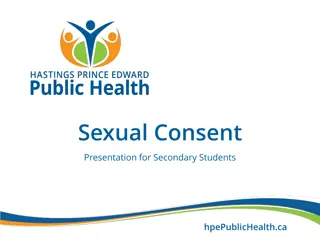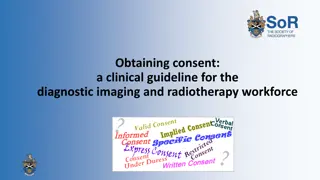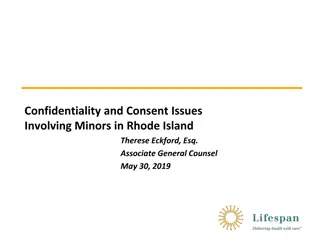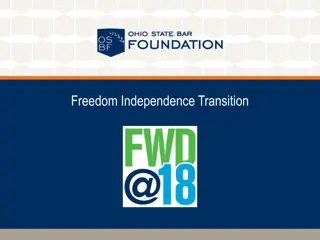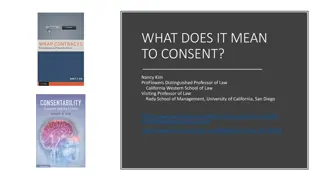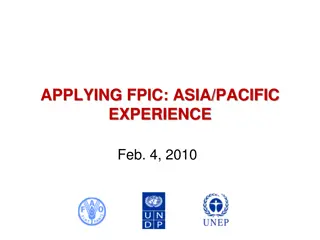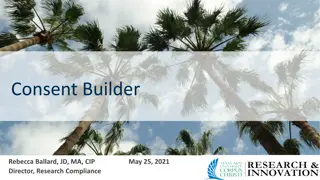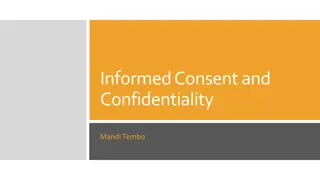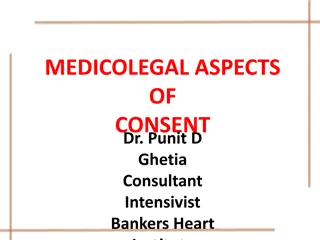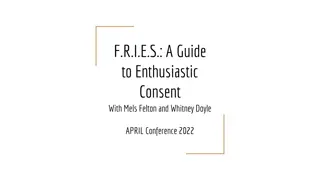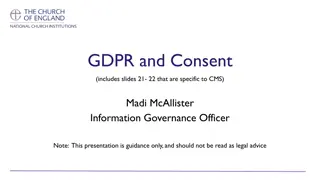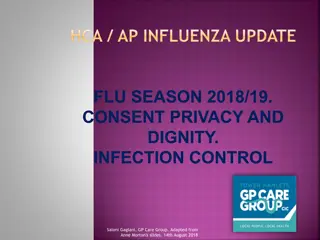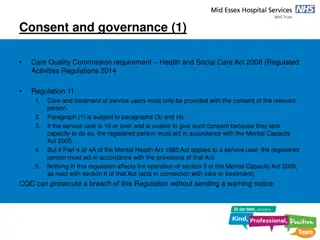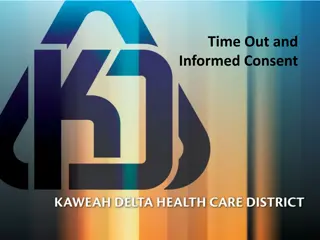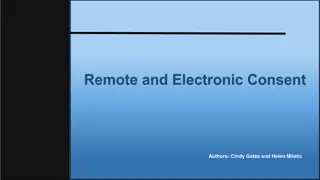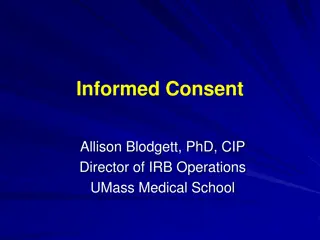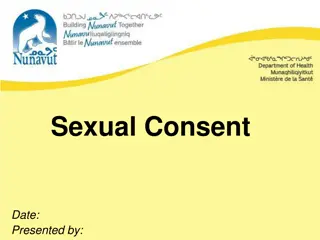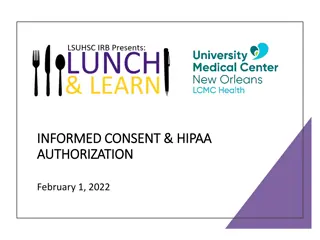Consent and Communication
Consent is a fundamental aspect of any sexual interaction, requiring clear and enthusiastic agreement. It is essential to communicate openly, respect boundaries, and ensure comfort for all parties involved. Consent can be withdrawn at any time, emphasizing mutual respect and understanding in healthy relationships.
Download Presentation

Please find below an Image/Link to download the presentation.
The content on the website is provided AS IS for your information and personal use only. It may not be sold, licensed, or shared on other websites without obtaining consent from the author.If you encounter any issues during the download, it is possible that the publisher has removed the file from their server.
You are allowed to download the files provided on this website for personal or commercial use, subject to the condition that they are used lawfully. All files are the property of their respective owners.
The content on the website is provided AS IS for your information and personal use only. It may not be sold, licensed, or shared on other websites without obtaining consent from the author.
E N D
Presentation Transcript
Data Science Core CHEAR Center for Data Science Deborah McGuinness Tetherless World Senior Constellation Chair Professor of Computer, Cognitive, & Web Sciences Director RPI Web Science Research Center RPI Institute for Data Exploration and Application Health Informatics Lead Adjunct Icahn School of Medicine at Mount Sinai November 4, 2015
Data and Metadata Standards the Data Center will work with the Laboratory Network and the Coordinating Center to identify and implement existing data and metadata standards to support the establishment of the infrastructure. The Data Science Resource will also lead a longer term, stakeholder-driven process to extend these and identify and address key gaps in existing standards in exposure domains represented in CHEAR. Data and metadata standards being developed and/or used in CHEAR will be catalogued and made available to the broader scientific community. From http://grants.nih.gov/grants/guide/rfa-files/RFA-ES-15-010.html
Vocabulary (family) for Exposure Science Community Lead a community of stakeholders with expertise appropriate for data standards development (e.g., ontologists, bioinformaticians, domain experts, technical developers) in the process of developing/adapting and implementing data/metadata standards for exposures, including approaches to: survey the landscape of existing data standards in the environmental domain to identify gaps or potential overlaps in standards, standards currently in development (e.g. ExO), and opportunities to build on current efforts; Identify and prioritize use cases around practical data issues of immediate relevance to CHEAR to address gaps in data/metadata standards; and Manage an iterative process of accessing, extending, developing, testing, and implementing data standards based on the use cases From http://grants.nih.gov/grants/guide/rfa-files/RFA-ES-15-010.html
Ontologies An ontology specifies a rich description of the Terminology, concepts, nomenclature Relationships among concepts and individuals Sentences distinguishing concepts, refining definitions and relationships (constraints, restrictions, regular expressions) relevant to a particular domain or area of interest. * Based on AAAI 99 Ontologies Panel McGuinness, Welty, Uschold, Gruninger, Lehmann Deborah L. McGuinness. ``Ontologies Come of Age ''. In Dieter Fensel, Jim Hendler, Henry Lieberman, and Wolfgang Wahlster, editors. Spinning the Semantic Web: Bringing the World Wide Web to Its Full Potential. MIT Press, 2003.
Use Case Approach Using a well used use-case driven methodology NIH also has recognized this approach Keynote at BD2K Workshop on Community-based Data and Metadata Standards Development: Best Practices to Support Healthy Development and Maximize Impact: http://1.usa.gov/1JeEI9P Starting points exist for use cases See a use case document with annotation: NIEHS Vocabulary Standards Use Case Template 1.23.15 at: http://bit.ly/1Jv5aHO from an NIEHS meeting in Jan 2015
Use Case Driven Methodology Originally developed for Virtual Observatories (in large physical observing centers e.g., NCAR) Now widely reused in many areas of natural science Basis of semantic eScience class McGuinness, Fox, West, Garcia, Cinquini, Benedict, Middleton The Virtual Solar-Terrestrial Observatory: A Deployed Semantic Web Application Case Study for Scientific Research. Innovative Applications of Artificial Intelligence http://www.vsto.org SuccessfulSemanticeScience Methodology http://tw.rpi.edu/web/doc/TWC_SemanticWebMethodology McGuinness, Lebo, Ding, McCusker, Shaikh, Moser, Morgan, Tatalovich, Willis, Hesse, Contractor, Courtney: Towards Semantically Enabled Next Generation Community Health Information Portals: The PopSciGrid Pilot. HICSS 2012:
Vocabularies / Resources Use Cases, data schemas, and advisors identify starting points: http://bit.ly/1LAjFyK Mount Sinai/RPI has worked with many vocabularies and resources RPI has worked with many relevant vocabularies and resources: ReDrugS: Bio2RDF, iRefIndex (and all protein-related subcomponents), GO, OMIM, UniProt, Drugbank, SIDER, SemNExT: Cortecon, GO, Ensembl, UMLS, NCBI gene, PROV, datacube vocabulary, String-DB, MediNet: UMLS, SNOMED-CT, ICU logs, health bulletin boards, .
Outreach, Input, Scoping Data Standards Working Group Workshops: 3 planned Publish early and often Web Observatory portal Downloadable ontologies (also plan to publish to bioportal) Browsable High level conceptual maps (cmaps) Plan to put up a wiki to support input Transdisciplinary leadership helps with outreach to many communities Leverage linkages to active communities such as Healthy Birth, Growth, and Development Knowledge Integration,
DOMAIN-DRIVEN ONTOLOGY DEVELOPMENT: SOURCES, WORKFLOW, TOOLS, INTEGRATION Sources Generated Vocabularies[1] Knowledge Base Integration Use Cases [1] * Driving Questions * Resource Discovery * User Stories Concepts Spreadsheet[2] Automated Tools Generated Ontology *(list ontology features) Repository Integration Existing Ontologies & Vocabularies [1] Expert Guidance Operational Definitions [1] Ontology Browser *Designed for collaboration * Integrated commentary * Provenance recorded * (other OB features) Database Schemas & Data Dictionaries [1] Knowledge- Enhanced Search Ontology Curation (ongoing) Expert Interviews (Internal Team) Expert Collaboration (External community) Reviewers & Curators *Ontology Development Team * Domain collaborators * Invited experts (domain, ontology) * "Consumers" (data analysts) [1] Crowdsourced (Google Docs, Sheets, etc) e.g. CHEAR DataScience Ontologies/Vocabularies [2] See backup slides for details
Possible Input Use cases that help identify vocabularies/ontologies Ontology pointers / Ontology repository pointers Evaluations of prominent ontologies (and gaps) Potential evaluators for ontologies Questions/Comments/Input? Deborah McGuinness dlm@cs.rpi.edu
Acknowledgements Rensselaer Polytechnic Institute Deborah McGuinness Kristin Bennett Paulo Pinheiro Jim McCusker Yue (Robin) Liu Evan Patton Mount Sinai Susan Teitelbaum Rochelle Osborne Nancy Mervish Chris Gennings Patricia Kovatch Jon Mercado Xin Zheng NIEHS (U2CES026555-01) David Balshaw Claudia Thompson Cindy Lawler 11
Connecting CHEAR with genetic and genomic databases Gene-environment interaction microarray GEO Regulatory genetic variants Functional genetic variants Array Express CTD FANTOM5 RVS CHEAR dbGap ENCODE Roadmap Epigenomics DIVAS GWAS catalog OMIM HGMD VarDi Disease genetic variants Rong Chen




